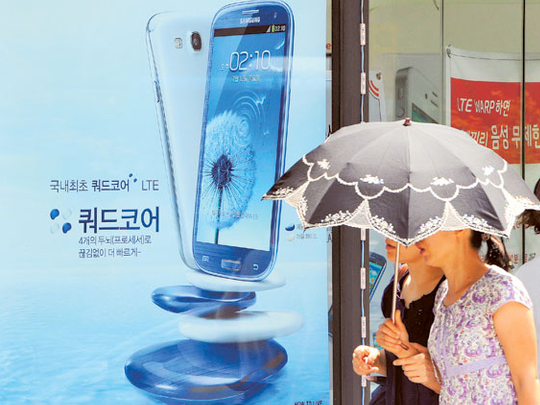
Dubai: Samsung Electronics has regained its leadership position in the second quarter after losing its lead in the smartphone segment to Apple.
Samsung shipped 50.2 million smartphones worldwide in the second quarter and had a market share of 33 per cent, up from 17 per cent a year ago. Apple’s fell slightly to 17 per cent, from 19 per cent a year ago. It sold 26 million iPhones in the second quarter.
“Apple’s shipments in the second quarter were impacted by a combination of factors, including macroeconomic variables, increased competition from newer smartphone offerings and delayed purchasing among consumers who are waiting for the availability of the next iPhone model. All this led to a buildup of channel inventory, resulting in lower-than-expected iPhone volumes,” said Wayne Lam, senior analyst, wireless communications, at IHS iSuppli.
By the end of the second quarter, about three million iPhones built up in the sales channel that weren’t sold to consumers. This contributed to the slowdown in Apple’s shipments during the quarter, reminiscent of the deceleration Apple experienced in the third quarter of last year as consumers waited for the release of the iPhone 4S. Apple should see a rebound in shipments “with the introduction of the next-generation iPhone model,” said Lam.
Samsung has successfully addressed all price segments of the smartphone spectrum, not just the high end of the market but also the midrange and particularly the low end. Furthermore, Samsung responds quickly to design leaders like Apple to “create variations of similar-themed products based on the Android platform,” he said.
According to research firm IDC, global smartphone shipments jumped 42 per cent year-over-year, but that the overall mobile phone market rose just one per cent. That means many users of so-called “feature” phones are switching to newer smartphones.
Overall, phone manufacturers shipped 154 million smartphones in the second quarter, a 42 per cent increase from 108 million a year earlier. That was slightly below IDC’s forecast of 43 per cent and was the slowest growth since the fourth quarter of 2009. At that rate, Lam said it would be tougher for Samsung and Apple to expand their market shares further. IDC said economic turmoil in Europe could put growth prospects at risk.
Including basic cellphones, vendors shipped 406 million units, up from 402 million a year earlier.
Samsung and Apple combined claimed nearly half of the smartphone market.
Nokia Corp was No 3 with a 6.6 per cent market share, down from more than 15 per cent a year ago. Nokia has had some success with its Lumia line, based on Microsoft’s Windows system. The company is hoping for a boost once Microsoft releases a major upgrade to Windows in October, one designed with touch screens in mind.
HTC Corp. was fourth with 5.7 per cent of the market, down from nearly 11 per cent.
Chinese phone maker ZTE Corp. claimed the No 5 spot for the first time, with a 5.2 per cent market share, up from 1.8 per cent a year earlier. Its lower-cost, entry-level smartphones have been popular in China and Latin America.
In smartphones, Samsung held 32.6 per cent of the market to 16.9 per cent for Apple and 6.6 per cent for third-place Nokia, which shipped 10.2 million smartphones.
Taiwan’s HTC was fourth with 8.8 million smartphones, accounting for a 5.7 per cent share, followed by China’s ZTE at 5.2 per cent for its eight million smartphones.
Robust sales of smartphones helped offset a slowdown in other consumer electronics businesses such as televisions and personal computers.
“The big question is how well Samsung’s phones will sell once the new iPhone comes out,” said Kevin Restivo, senior research analyst with IDC.
“Samsung and Apple have quickly become the global smartphone heavyweights though both employ somewhat different approaches to the market,” said Restivo.
“Samsung employs a ‘shotgun’ strategy wherein many models are created that cover a wide range of market segments. Apple, in contrast, offers a small number of high-profile models. While both companies have expanded their geographic presence in pursuit of market share, the two companies will inevitably come into greater conflict as both try to generate additional gains.”










